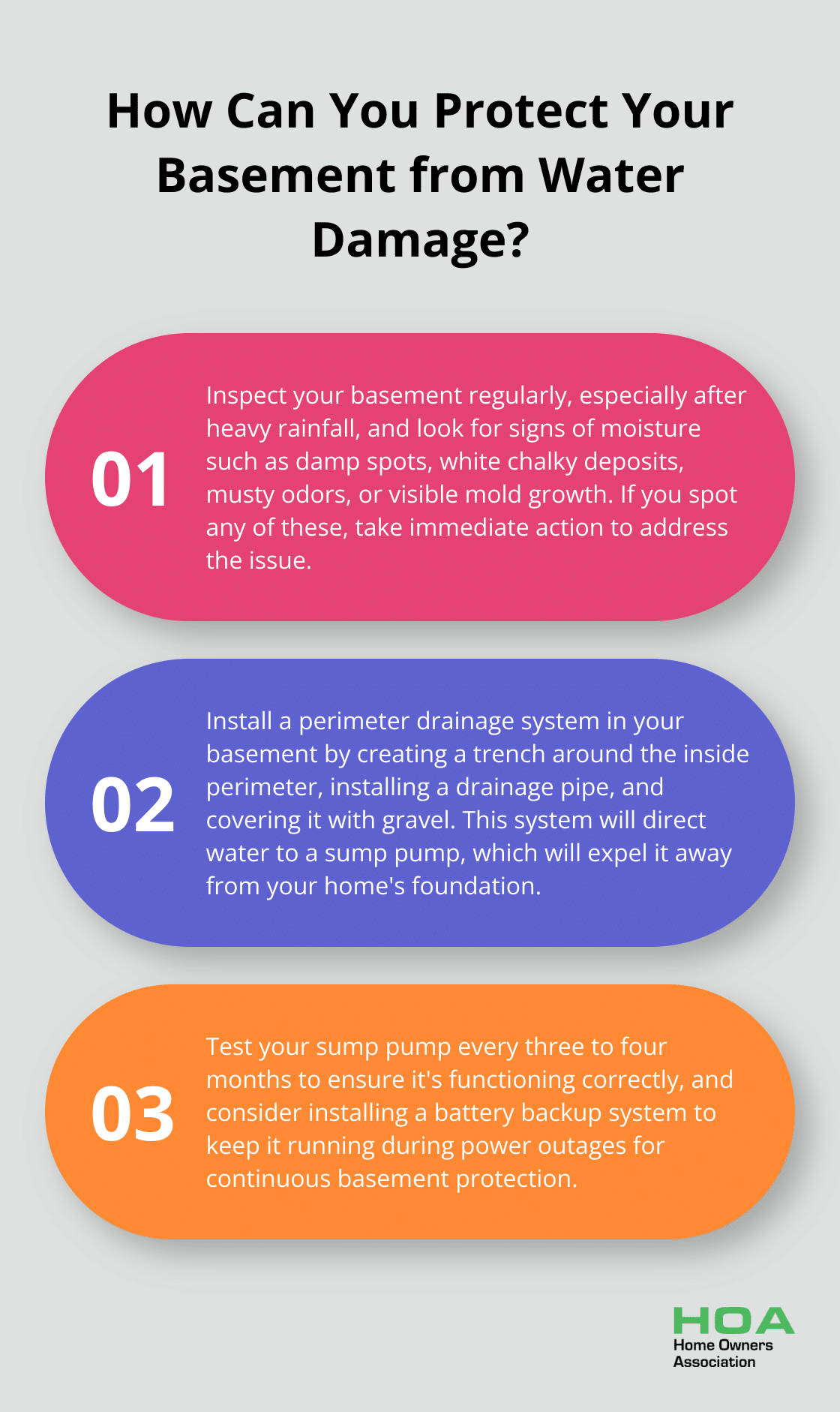
At Home Owners Association, we understand the importance of protecting your home’s foundation. A dry basement is essential for maintaining your property’s structural integrity and your family’s health.
Home basement waterproofing is a critical step in safeguarding your house against moisture damage. This guide will walk you through the process, helping you identify issues and choose the best solutions for your home.
What Is Basement Waterproofing?
The Essence of Basement Protection
Basement waterproofing is the process that protects your home’s foundation from water damage. It creates a barrier between your basement and the moisture in the surrounding soil. This protection goes beyond preventing puddles on your floor; it safeguards your home’s structural integrity and your family’s health.
The Pervasive Threat of Moisture
Moisture in basements is more common than many realize. Reports show that approximately 98% of basements in the country will experience some form of water damage during their lifespan. This isn’t a minor inconvenience – it can lead to serious issues like mold growth.
Common Culprits of Basement Moisture
Several factors contribute to basement moisture:
-
Poor Drainage: If your yard doesn’t slope away from your house at a rate of at least six inches over 10 feet, water can pool around your foundation.
-
Faulty Gutters: Clogged gutters or downspouts that don’t extend far enough from your home (at least 15 feet) can cause water to accumulate near the foundation.
-
Foundation Cracks: Even small cracks can allow water to seep into your basement.
Recognizing the Warning Signs
Early detection of water intrusion can save thousands in repairs. Look out for these indicators:
-
Damp spots on walls or floors (especially after heavy rain)
-
Efflorescence (white, chalky deposits on concrete)
-
Musty odors
-
Visible mold growth
Proactive Measures
Don’t wait for a flood to take action. Regular inspections of your basement, particularly after heavy rainfall, can catch problems early. If you spot any signs of moisture, it’s time to consider waterproofing solutions.

For minor issues, you might start with simple fixes like improving your yard’s grading or extending your downspouts. However, more serious problems might require professional waterproofing methods such as installing an interior French drain or applying exterior waterproof coatings.
The cost of waterproofing is far less than the potential damage from water infiltration. With basement flooding being five times more likely than a house fire over a 30-year mortgage, proper waterproofing is a smart investment for any homeowner.
Now that we understand what basement waterproofing entails and why it’s important, let’s explore the various methods available to keep your basement dry and your home protected.
Effective Basement Waterproofing Methods
Interior Waterproofing: Your First Line of Defense
Interior waterproofing offers an accessible and cost-effective starting point for protecting your basement. This method applies waterproof coatings or membranes to the inside walls and floors of your basement. Epoxy injections seal small cracks effectively, preventing water seepage. For larger cracks, hydraulic cement expands as it dries to create a watertight seal.

A popular interior method involves the installation of a perimeter drainage system. This process creates a trench around the inside perimeter of your basement, installs a drainage pipe, and covers it with gravel. The system directs water to a sump pump, which then expels it away from your home’s foundation.
Exterior Waterproofing: The Ultimate Protection
Exterior basement waterproofing prevents water from entering your basement rather than managing water that has already gotten in. This method excavates the soil around your home’s foundation to apply a waterproof membrane or coating directly to the exterior walls.
A properly installed exterior waterproofing system can last up to 25 years (according to the Basement Health Association). However, it requires experienced professionals for proper installation. Improper execution can lead to severe water issues and potentially compromise your home’s structural integrity.
Drainage Systems: Redirecting Water Away
French drains, installed either inside or outside your home, redirect groundwater away from your foundation effectively. Installing a French drain costs $500 to $18,000, with a national average of $9,250. The investment in a proper drainage system pays off by preventing water accumulation near your home’s foundation.
Sump Pumps: The Unsung Heroes
Sump pumps work tirelessly to pump out water that accumulates in the sump pit, preventing flooding. Regular testing (every three to four months) ensures your sump pump functions correctly. Consider installing a battery backup system to keep your pump running during power outages, providing continuous protection for your basement.
Comprehensive Approach for Maximum Protection
The most effective waterproofing strategy combines interior and exterior methods with proper drainage systems. This multi-faceted approach provides the best protection for your home. Consulting with waterproofing experts helps determine the best solution for your specific situation.
As we move forward, let’s explore when to tackle waterproofing as a DIY project and when to call in the professionals.
DIY or Professional Waterproofing: Making the Right Choice
Assessing DIY Waterproofing Options
For minor issues like small cracks or slight dampness, DIY methods can prove effective. Applying a waterproof sealant or filling small cracks with hydraulic cement are tasks many homeowners can handle. These solutions typically cost between $100 to $500 (depending on the products and area covered).

However, DIY has its limits. The National Association of Home Builders represents the largest network of craftsmen, innovators and problem solvers dedicated to building and enriching communities.
The Advantages of Professional Waterproofing
For severe water problems or if you can’t identify the source of moisture, professional services offer the best solution. Experts possess the tools and knowledge to diagnose complex issues and implement comprehensive solutions.
The average cost of basement waterproofing ranges from $3 to $10 per square foot, with various factors influencing the final price. While this might seem steep, it’s a fraction of the potential cost of water damage, which averages $7,500 per incident, as reported by the Insurance Information Institute.
Hidden Costs of DIY Approaches
While DIY might appear cheaper upfront, hidden costs can accumulate. Tools, materials, and your time all have value. Moreover, if you make mistakes, the cost to fix them can exceed what you would have paid for professional services initially.
A study by the Basement Health Association found that 43% of DIY waterproofing projects required professional intervention within two years, often at a higher cost than if professionals had been hired initially.
Long-Term Value of Professional Work
Professional waterproofing often includes warranties, some extending up to 25 years. This long-term protection provides peace of mind and can increase your home’s value. The National Association of Realtors reports that homes with professional waterproofing sell for 10% more on average than those without.
Factors to Consider in Your Decision
The decision between DIY and professional waterproofing depends on your specific situation. For minor issues in accessible areas, DIY can provide a cost-effective solution. However, for comprehensive, long-lasting protection, especially in areas with high water tables or severe weather, professional services often provide the best value.
We recommend obtaining a professional assessment before deciding. Many waterproofing companies offer free inspections, giving you valuable insights without upfront costs. This information can help you make an informed decision about whether to DIY or hire professionals for your basement waterproofing project.
Final Thoughts
Home basement waterproofing protects your property’s future and prevents minor issues from becoming major, costly repairs. A dry basement increases property value, lowers energy costs, and provides peace of mind against water damage. You should conduct a thorough assessment of your basement, looking for signs of moisture and documenting areas of concern.

Professional advice can offer valuable insights for complex problems, while DIY methods might suffice for minor issues. The key is to act decisively and create a comprehensive waterproofing strategy tailored to your home’s specific needs. This approach not only solves current problems but also invests in your home’s longevity and your family’s comfort.
At Home Owners Association, we help homeowners in Melbourne, Australia, make informed decisions about their properties. Our members receive expert advice, trade pricing, and resources to ensure successful home improvement projects. You can approach your waterproofing project with confidence, knowing you have support from a trusted partner in home maintenance and improvement.





